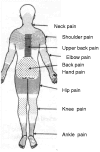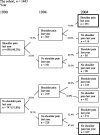Patterns of shoulder pain during a 14-year follow-up: results from a longitudinal population study in Norway
- PMID: 27582957
- PMCID: PMC4935093
- DOI: 10.1177/1758573214552007
Patterns of shoulder pain during a 14-year follow-up: results from a longitudinal population study in Norway
Abstract
Background: Population studies have reported that shoulder pain is the third most frequently reported musculoskeletal pain. Long duration, pain intensity and high level of disability predict persistent complaints. The present study aimed to describe the prevalence of shoulder pain in a general population and follow this over a long period (1990 to 2004). The objective was also to describe the stability of shoulder pain and patterns of co-occurrence with neck and upper back pain.
Methods: Data were obtained from a self-reported questionnaire in a population in Ullensaker muncipality, north-east of Oslo. The Standard Nordic Questionnaire was sent in 1990, 1994 and 2004 to inhabitants belonging to six birth cohorts from 1918-20 to 1968-70.
Results: The 1-year prevalence of shoulder pain was 46.7% (95% CI, 44.9% to 48.6%) in 1990, 48.7% (95% CI, 46.8% to 50.5%) in 1994, and 55.2% (95% CI, 53.5% to 56.9%) in 2004. Approximately three-quarters of the persons with shoulder pain at one given time also reported shoulder pain at the next follow-up.
Conclusions: Prevalence of shoulder pain during a 14-year period was high and slightly increasing. Shoulder pain was reported most frequently in co-occurrence with neck pain. Classification models should include neck pain as well as other co-occurring pain sites.
Keywords: co-existing pain; prevalence; shoulder pain; stability of pain.
Figures
References
-
- Natvig B, Nessioy I, Bruusgaard D, Rutle O. [Musculoskeletal complaints in a population. Occurrence and localization]. Tidsskr Nor Laegeforen 1994; 114: 323–7. - PubMed
-
- Picavet HS, Schouten JS. Musculoskeletal pain in the Netherlands: prevalences, consequences and risk groups, the DMC(3)-study. Pain 2003; 102: 167–78. - PubMed
-
- Picavet HS, Schouten JS. Musculoskeletal pain in the Netherlands: prevalences, consequences and risk groups, the DMC(3)-study. Pain 2003; 102: 167–78. - PubMed
LinkOut - more resources
Full Text Sources
Other Literature Sources



